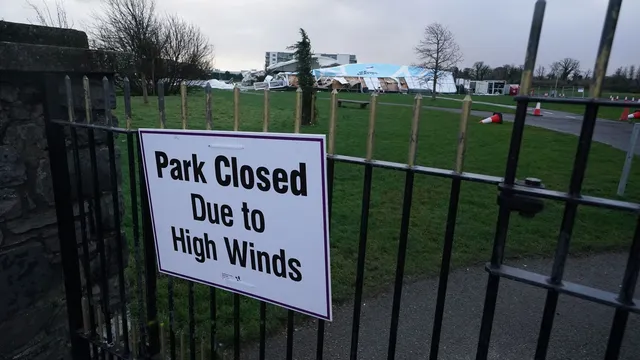
Storm Herminia brings destructive winds and flooding to the UK
2025-01-28 06:00- Severe weather warnings for wind and rain were issued as Storm Herminia arrived in the UK after Storm Eowyn.
- The storm caused significant travel disruptions, including flight cancellations and railway service interruptions.
- The aftermath of the storms has led to flooding, power outages, and evacuations, indicating a continued severe weather threat.
Express your sentiment!
Insights
The UK is currently grappling with the aftermath of Storm Herminia, a low-pressure system that has caused significant disruption across the country, particularly impacting southern regions. This follows the severe impact of Storm Eowyn, which brought hurricane-force winds and resulted in two fatalities. The Met Office issued multiple weather warnings for wind and rain as Herminia approached, bringing with it wind gusts reaching up to 83mph. The storm's heavy rains have led to flooding, with over 50 flood warnings in place, particularly affecting the south-west where the environment agency is urging immediate action for those living in vulnerable areas. Transport services faced severe disruptions with numerous flight cancellations primarily at Heathrow, impacting thousands of passengers en route to both domestic and European destinations. Rail services were also affected, exacerbating the challenges posed by the inclement weather. As Storm Herminia made its way across the UK, it was reported that properties were flooded, and a major incident was declared in Somerset due to the extent of the flooding, which necessitated evacuations. The troubles the UK faces stem from a sequence of storms already affecting the region. Just prior to Herminia, Storm Eowyn wreaked havoc, leaving more than a million people without power and leading to uprooted trees and damaged buildings. This combination of successive storms is contributing to an already saturated ground, prompting fears about further flooding and the impacts on infrastructure and safety. Forecasters predict that while Storm Herminia is not expected to be as disastrous as Storm Eowyn, it will continue to inflict damage in the form of strong winds and heavy rainfall. The Met Office remains vigilant, issuing warnings that suggest potential danger to life from flooding in certain areas. The weather forecast indicates that unsettled conditions will persist through the week, highlighting the ongoing challenges for communities recovering from the storms.
Contexts
The history of storms in the UK is a fascinating reflection of the country's climatic variations and environmental challenges. The UK is located in a temperate maritime climate zone, characterized by frequent atmospheric disturbances that result in an array of weather phenomena, including storms. Over the centuries, the UK has faced numerous notable storms, some of which have left significant impacts on the environment, infrastructure, and communities. Historical records date as far back as the 13th century, documenting severe weather events. The Great Storm of 1987, for example, was one of the most devastating storms in recent memory, causing widespread damage and loss of life, and leading to changes in how weather predictions and warnings are issued in the country. Such events reveal the underlying vulnerability of both urban and rural areas to extreme weather conditions brought on by storms. The frequency and intensity of storms in the UK have been influenced by various factors, including climatic changes and geographical positioning. The North Atlantic system plays a critical role in generating storms that sweep across the British Isles, often bringing heavy rain, strong winds, and rough seas. The impact of global warming cannot be ignored, as studies indicate an increase in the intensity of storms, alongside rising sea levels that threaten coastal communities. Recent storms, such as Storm Ciara and Storm Dennis in February 2020, have resulted in significant flooding and disruption, highlighting how the UK continues to face substantial risks from severe weather despite advancements in meteorology. Moreover, the historical response to storms in the UK demonstrates a continuous evolution in disaster preparedness and adaptability. The government's role in implementing emergency management strategies has transformed dramatically over the years. Modern technological advancements have enhanced forecasting accuracy, allowing for timely warnings that can save lives and minimize economic impacts. Community engagement has also become essential in response strategies, particularly in high-risk areas where local knowledge can improve resilience to storm impacts. In summary, the history of storms in the UK illustrates an ongoing battle between nature and human society, where adaptation and preparedness are crucial in mitigating risks. Understanding past storm patterns and their socio-economic consequences is essential for informing future policies and improving resilience strategies. Continued research and investment in infrastructure, alongside community involvement, will be pivotal in addressing the challenges posed by increasingly severe storms as climate change progresses.